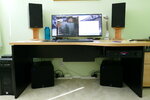Focal, Yamaha, and Adam audio are good mid-high tier options for near and midfield audio imaging which is what you are proposing. Adam and Focal are among the top tier of speaker providers in my opinion where studio monitors are concerned.
Particularly if you wanted studio monitors/shelf mounted speakers with above average audio.
I'd suggest you get speakers with their own amplification, as this would solve your routing and device selection.
A pair of speakers that I personally drool over, and plan to own, costs your total proposed budget.

The bonus of studio monitors is they are typically TRS or XLR connectors which makes them easy to adapt to other purposes if you know how. XLR cables are more robust than traditional speaker wire, and very easy to repair or modify.
So here is a setup that I would do, and plan to do for a limited space environment in my own place. My choices in equipment my vary slightly from what is here but it is essentially what I'd choose.
Yamaha HS5's are decent, cost around 400 bucks for a pair.
Adam Audio A7x's are about 749 a piece.
Focal Shape 6.5's 900 a piece.
I would suggest a studio DAC, such as one from Arturia if your budget permits.
The Audio Fuse studio or Audio Fuse Rev 2 are excellent DAC's with a multi-tude of input's and outputs (analog and digital). The Fuse Rev 2 also has a very small foot print and comes with it's own hard shell travel case. The Fuse Studio is slightly larger with more sound options but doesn't cost that much more than the Fuse Rev 2.
Using an external DAC as your encoder and pre-amp, then routing it to a good set of 2 or 3 way powered speakers is one way of simplifying your overall setup. Arturia's latest gen DAC's also permit Bluetooth interface.
Should you decide on a more advanced Arturia at some point, these will integrate with each other digitally and offer expanded abilities as well.
The Fuse Rev 2 costs about 560 dollars, the Fuse Studio costs about 890. Arturia's DAC's are some of the best you can get for the money spent and provide decent amplification on their own. These do have a digital back end that talks to a mac, pc or compatible mobile device but they are designed to be operated as a stand alone box also.
A compatible powered sub would permit the full range of ultra-low, mid and high to be represented in all it's glory with the aforementioned types of speakers.
Combine with all the above, you can EQ it to your hearts content if it's not quite right.





